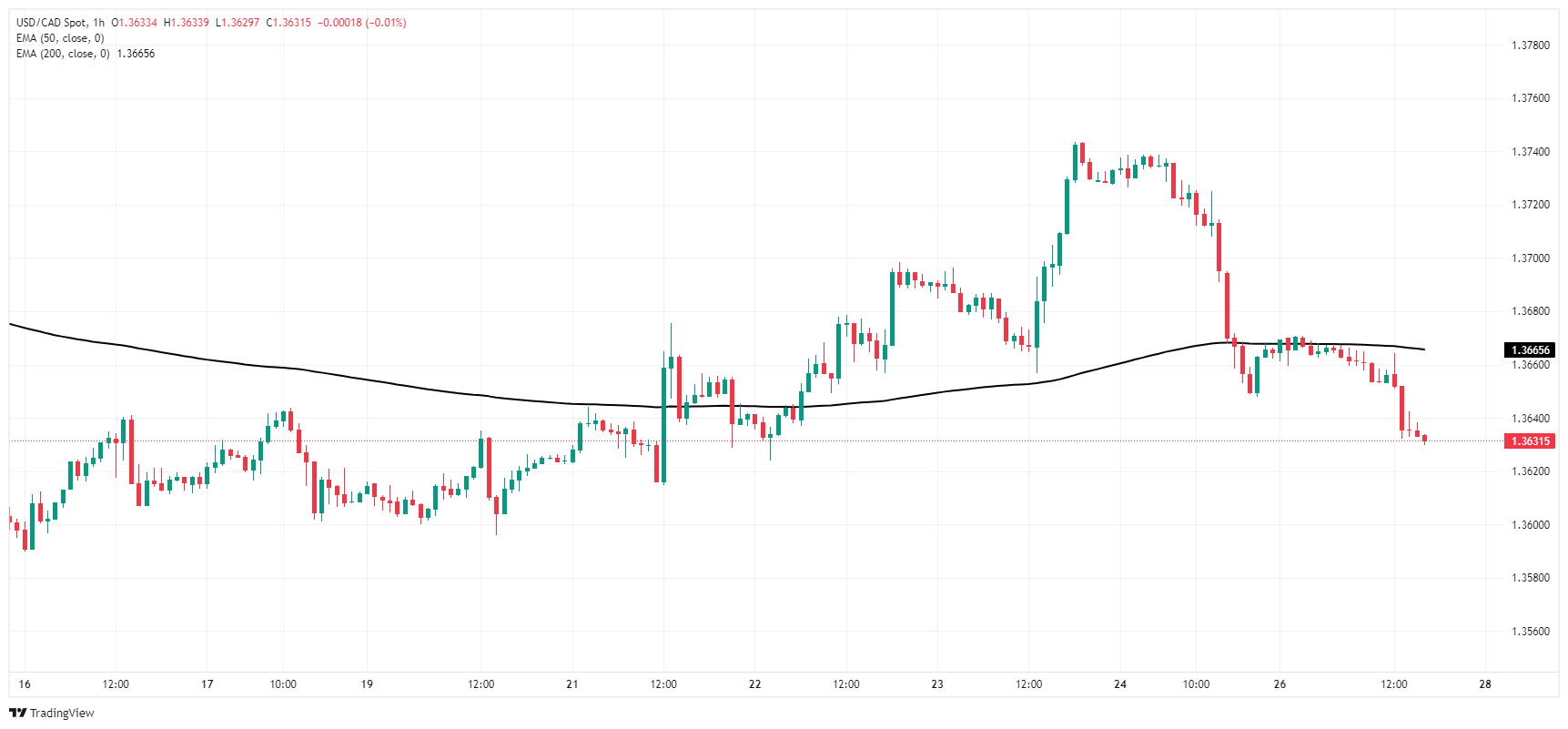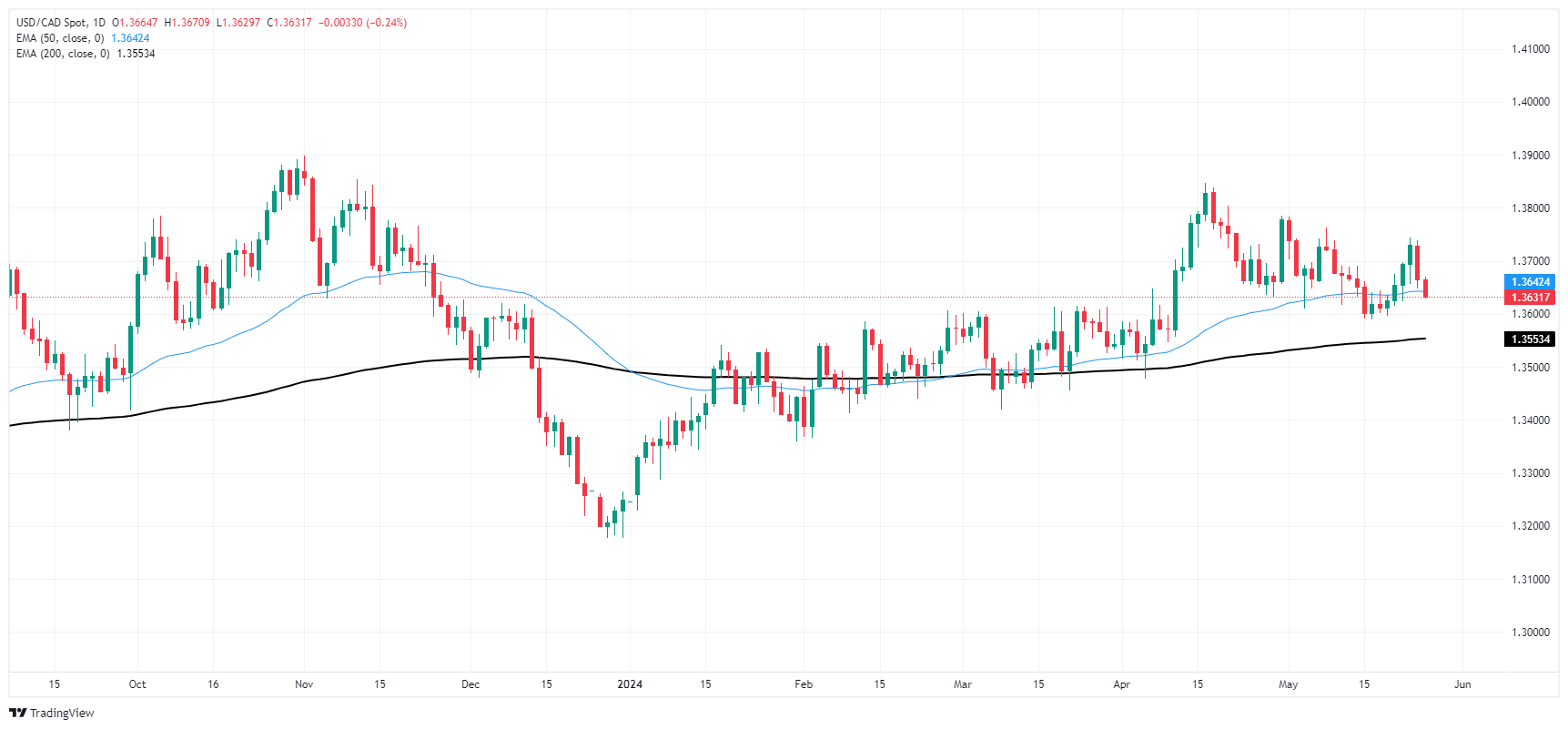Canadian Dollar gains ground against holiday-weakened Greenback

- Canadian Dollar climbs over Greenback but gives mixed Monday performance.
- Canada brings little of note to the economic calendar until Friday’s GDP release.
- Memorial Day holiday keeps US markets dark, leaves market volumes thin.
The Canadian Dollar (CAD) is mixed on Monday, climbing against the US Dollar (USD) thanks to a quiet US market session. US markets are dark for the Memorial Day holiday, leaving CAD traders to twist in the breeze and await meaningful data prints.
Canada has little of note on the economic calendar early this week, and the release schedule is littered with low-impact figures until Thursday’s Canadian Current Account for the first quarter, which is expected to decline to -5.88 billion versus the previous -1.62 billion. Friday brings a fresh print of Canadian Gross Domestic Product (GDP), which is forecast to ease to a flat 0.0% MoM compared to the previous 0.2%. However, Friday’s Canadian GDP is likely to be overshadowed by key US inflation figures being released at the same time.
Daily digest market movers: Quiet Monday markets give Canadian Dollar a leg up on Greenback weakness
- Canadian Dollar is gaining ground on Monday, due more to fresh weakness in safe haven currencies than any particular CAD-based bidding power.
- According to a StatCan flash estimate, wholesale trade in Canada likely rose 2.8% MoM in April, a welcome sign for investors fearing a potential recession in the Canadian economy.
- Canadian Industrial Product Prices, due to be released on Tuesday, are expected to slow to 0.6% MoM growth from the previous 0.8%.
- Canadian Raw Material Price Index is also expected to recede to 3.2% MoM growth from the previous 4.7%.
- Tuesday will kick off the American trading week with appearances from several key Federal Reserve policymakers as Fedspeak remains a key driver of market flows.
Canadian Dollar PRICE Today
The table below shows the percentage change of Canadian Dollar (CAD) against listed major currencies today. Canadian Dollar was the strongest against the US Dollar.
| USD | EUR | GBP | JPY | CAD | AUD | NZD | CHF | |
|---|---|---|---|---|---|---|---|---|
| USD | -0.12% | -0.25% | -0.06% | -0.25% | -0.40% | -0.54% | -0.11% | |
| EUR | 0.12% | -0.16% | 0.09% | -0.14% | -0.34% | -0.52% | 0.05% | |
| GBP | 0.25% | 0.16% | 0.18% | -0.01% | -0.18% | -0.27% | 0.17% | |
| JPY | 0.06% | -0.09% | -0.18% | -0.22% | -0.35% | -0.40% | -0.07% | |
| CAD | 0.25% | 0.14% | 0.00% | 0.22% | -0.17% | -0.29% | 0.09% | |
| AUD | 0.40% | 0.34% | 0.18% | 0.35% | 0.17% | -0.10% | 0.35% | |
| NZD | 0.54% | 0.52% | 0.27% | 0.40% | 0.29% | 0.10% | 0.43% | |
| CHF | 0.11% | -0.05% | -0.17% | 0.07% | -0.09% | -0.35% | -0.43% |
The heat map shows percentage changes of major currencies against each other. The base currency is picked from the left column, while the quote currency is picked from the top row. For example, if you pick the Canadian Dollar from the left column and move along the horizontal line to the US Dollar, the percentage change displayed in the box will represent CAD (base)/USD (quote).
Technical analysis: Canadian Dollar steps over softening Greenback
The Canadian Dollar (CAD) is broadly mixed on Monday, gaining around a quarter of a percent against the US Dollar and the Japanese Yen (JPY). However, the CAD is falling back against the Antipodeans, shedding a quarter of a percent against both the Australian Dollar (AUD) and the New Zealand Dollar (NZD).
USD/CAD fell back into familiar congestion on Monday, extending a decline from last week’s late peak near 1.3740. The pair is set to run aground of technical support near the 1.3600 handle, with a long-term floor priced in at the 200-day Exponential Moving Average near 1.3553.
USD/CAD hourly chart
USD/CAD daily chart
Risk sentiment FAQs
In the world of financial jargon the two widely used terms “risk-on” and “risk off” refer to the level of risk that investors are willing to stomach during the period referenced. In a “risk-on” market, investors are optimistic about the future and more willing to buy risky assets. In a “risk-off” market investors start to ‘play it safe’ because they are worried about the future, and therefore buy less risky assets that are more certain of bringing a return, even if it is relatively modest.
Typically, during periods of “risk-on”, stock markets will rise, most commodities – except Gold – will also gain in value, since they benefit from a positive growth outlook. The currencies of nations that are heavy commodity exporters strengthen because of increased demand, and Cryptocurrencies rise. In a “risk-off” market, Bonds go up – especially major government Bonds – Gold shines, and safe-haven currencies such as the Japanese Yen, Swiss Franc and US Dollar all benefit.
The Australian Dollar (AUD), the Canadian Dollar (CAD), the New Zealand Dollar (NZD) and minor FX like the Ruble (RUB) and the South African Rand (ZAR), all tend to rise in markets that are “risk-on”. This is because the economies of these currencies are heavily reliant on commodity exports for growth, and commodities tend to rise in price during risk-on periods. This is because investors foresee greater demand for raw materials in the future due to heightened economic activity.
The major currencies that tend to rise during periods of “risk-off” are the US Dollar (USD), the Japanese Yen (JPY) and the Swiss Franc (CHF). The US Dollar, because it is the world’s reserve currency, and because in times of crisis investors buy US government debt, which is seen as safe because the largest economy in the world is unlikely to default. The Yen, from increased demand for Japanese government bonds, because a high proportion are held by domestic investors who are unlikely to dump them – even in a crisis. The Swiss Franc, because strict Swiss banking laws offer investors enhanced capital protection.
